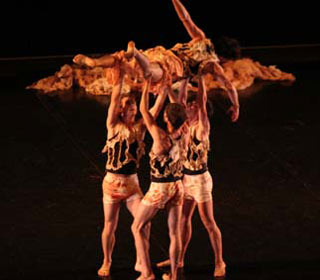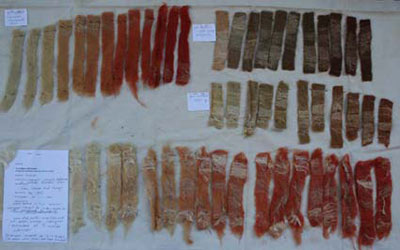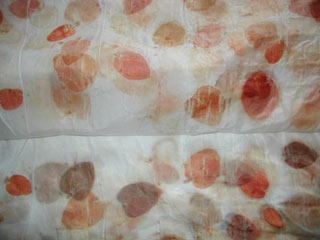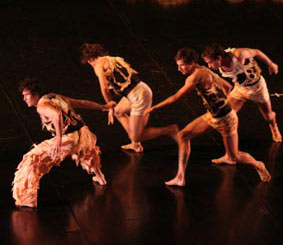Human Flower Project
India Flint—Eucalyptus Dancing
Thanks to Australian textile artist India Flint for this account of her latest work: costuming the dancers in a new ballet using silks and home grown wools, scented and colored with local plants. Bravo, India!

“Ash” from Frances Rings’s ballet ‘debris’
Perth International Festival of Arts, 2/07
costumes by India Flint
By .(JavaScript must be enabled to view this email address)
In February this year the West Australian Ballet Company took the bold initiative of commissioning a new work as part of their Perth International Festival of Arts program. Called ‘debris,’ it featured music by Peter Sculthorpe and Philip Glass and choreography by Frances Rings. I was honoured to be asked to make the costumes.
Not only was the style of the dance different from the ballet’s mostly classical program, so were the costumes. Instead of tulle, tutus and tights, the dancers were clothed in soft silk-wool shifts over fine merino wool knits. In place of spangles and sequins, the fabrics were patterned with the rich colours of the landscape, dyed into the cloth using leaves, bark and flowers.
 Dye samples:
Dye samples:
Leaves from Eucalyptus cinerea and E. sideroxylon for the dark reds;
leaves, bark and flowers from E.globulus and E. citriodora for browns, pinks and purples
Photo: Courtesy of India Flint
The costumes for ‘debris’ were developed in close consultation with Frances Rings—as I watched the lyrical choreography magically unfold in rehearsal. The ballet took for its subject ‘that which we use and subsequently discard’ and ‘the value of the lost and found.’ These themes are familiar territory for me and relate closely to my own ‘benedictus’ pieces. They’re made from second-hand goods and dye materials found in and around the Mount Lofty Ranges of Southern Australia, where I live.
Making re-crafted clothing, each piece unique and individually considered, is a slower kind of fashion … like slow food. The dyes come largely from windfall eucalypts (which give their beautiful aroma to the cloth) and roadside weeds (more poetically described as spontaneous flora), supplemented by plants grown in my garden. I avoid imported dyes as these are often harvested without due consideration.
 Flint’s ecoprint technique
Flint’s ecoprint technique
makes distinctive leaf marks
Photo: Courtesy of India Flint
For ‘debris,’ I chose silk and wool, two renewable textile resources whose production—when managed properly—can have less impact on the environment than organic cotton does. Also, I selected these fabrics for their rich and sumptuous feel, thinking of the dancers’ comfort.
The wool was used in its most refined form, a luxurious jersey, as well as sturdy hand-formed felt made of wool harvested from sheep at ‘Hope Springs,’ the property where I live and work. All these colours, sourced from Australia’s indigenous plants, are quite literally the colours of the land. I believe that when cloth is dyed in the very stuff of a country, some of the essence of that country remains in the work even when it travels far. Silk and wool both take up the vivid colours offered by eucalyptus dyes without adjunct chemical mordants; only water is needed to make the dye bath. This means that the cloth itself will not be shedding toxic substances onto the dancers’ skin as they work.
 Scene from ‘debris’
Scene from ‘debris’
Each segment of the ballet has its own particular essence. It begins with ‘dawn,’ moving into ‘shell’, ‘ash’, ‘bone’ and ‘stone.’ The dancers awaken under a huge cloth constructed of silk netting with wool felt and hand-stitching, shifting and moving until it gradually reveals them to the dawn. ‘Ash’ evokes consumption by the furious energy of fire, as much as the soft, cold remnant powdering underfoot when the fire burns out. Stone can be a tool, a foundation or the substance of memory. Throughout the shifting poetry of the performance, the dancers acquired and discarded these costumes on stage, like flesh leaving bone; finally, their forms were revealed beneath the last layer – a fine, skin-hugging wool jersey, the colour of red earth.


Julie:: THis is just such a wonderful site. I continue to be educated and plant more flowers in honor thereof. More lavender, more lavender. Rose Bush was out to visit. Think of you often and this cool site.
aa (angela)